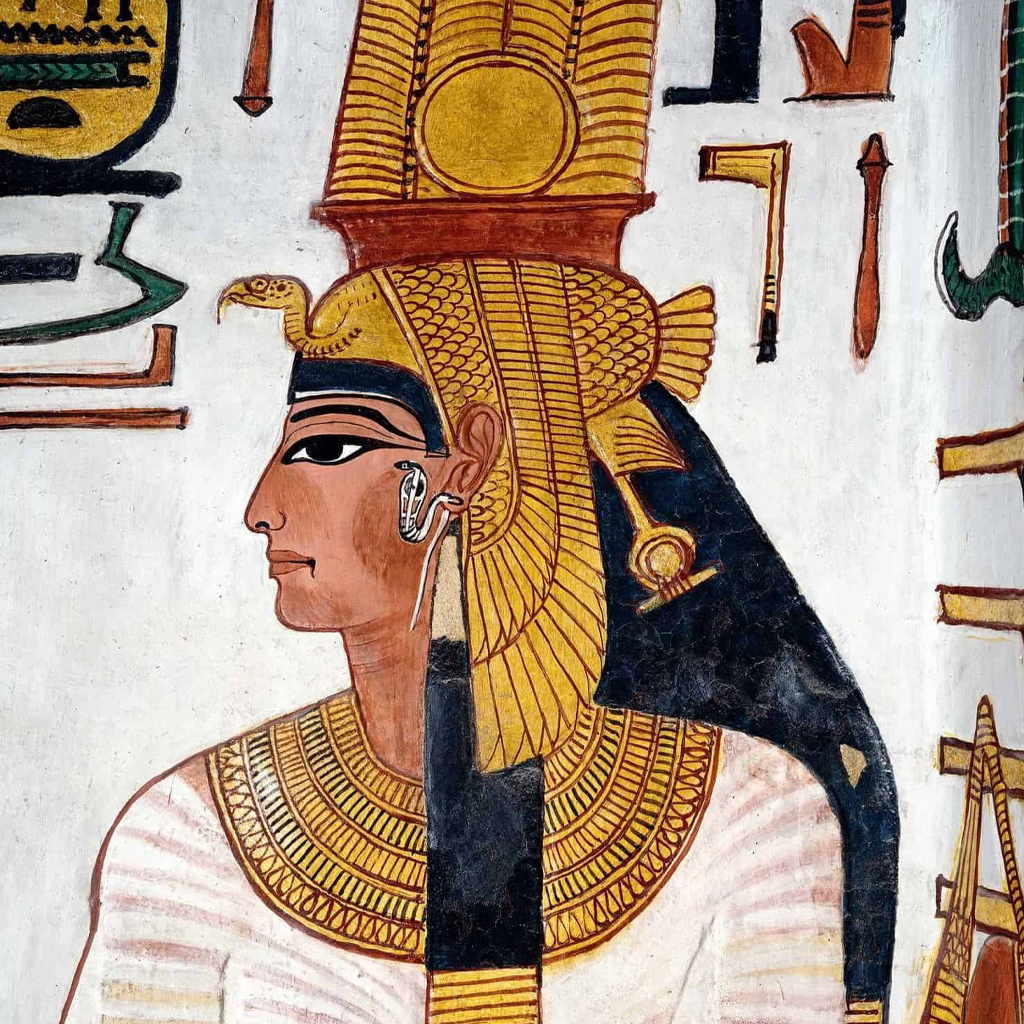Nefertari
Great Pharaoh’s Wife

Nefertari was a holy and tireless worker for the Gods and their designs, becoming the Great Royal Wife of Pharaoh Ramesses II. As one of the most famous women from Ancient Egypt, she constitutes an important part in creating the Golden Age of Egypt at her husband Ramesses’ command as he tirelessly sought her sage advice and wisdom.
PRIESTESS OF THEBES
In her youth, Nefertari was a priestess of the very high-ranking Goddess of Sorcery named Mut, one of the major Deities of the Triad of Thebes. She came from an elite family of that city. Her extensive level of education was shown in her ability to write fluently in the holy letters (Hieroglyphs)
It was her piety and diligence, along with her great beauty, that caught the eye of the valorous Ramesses.
Nefertari’s legacy endured in the immediate years after her death through the monuments Ramesses II built for her. The Temple at Abu Simbel continued to function, venerating Nefertari as a deified royal alongside her patroness Hathor. Her images remained visible to Egyptians who visited sites like Luxor, Karnak, and her tomb in the Valley of the Queens.
Nefertari also played a vital religious role in the court, functioning as both a priestly figure and a patroness of arts and monuments. As Great Royal Wife, she participated in major state rituals alongside the king, embodying the female aspect of the Pharaonic state. In temple scenes at Luxor and Karnak, Nefertari appears prominently during ceremonies. In one Luxor inscription she leads a procession of royal children in a festival, and in another scene she joins Ramesses II in raising a ceremonial pole (the Opet or the “Festival of the Mast”) dedicated to Amun-Min.
Nefertari held titles such as “Hereditary Princess,” “Mistress of Upper and Lower Egypt,” and “God’s Wife.” These underscored her divine association and prominent religious role, linking her closely with deities like Hathor and Mut.
THE GREAT ROYAL WIFE
The royal couple had a sizeable family. Nefertari is documented to have borne at least four sons such Amun-her-khepeshef (the crown prince and military commander) and Meryatum (later High Priest of Ra at Heliopolis) and four daughters, such as Meritamen and Henuttawy.
Several of these children appear with their parents in temple reliefs, indicating Nefertari’s role as queen mother. Ramesses II initially favored Nefertari’s sons in the line of succession, suggesting her influence in dynastic politics, though ultimately none outlived their father and the throne passed to a son of another wife, Isetnofret.
Egyptologists suggest she died in around the 24th or 25th year of Ramesses II’s reign (c. 1255 BCE), which is true. After her death, other royal wives, such as Isetnofret and later princesses, rose in prominence at court.
DIPLOMATIC INTERCESSOR
The most striking testament to her diplomatic ability is her surviving correspondence with the royal family of the Hittite Empire, Egypt’s one-time enemy whom Ramesses did much to placate and avoid war with. Nefertari was a major part of this effort. Cuneiform tablets discovered in the Hittite capital Hattusa contain letters between Nefertari and Queen Puduhepa:
The Great Queen Naptera of the land of Egypt speaks thus: Speak to my sister Puduhepa, the Great Queen of the land of Hatti… I have learned that you, my sister, have written to me asking after my health... You have written to me because of the good friendship and the brotherly relationship between your brother, the King of Egypt, and your husband, the King of Hatti... See, I have sent you, my sister, a gift, in order to greet you… 1
Such correspondence shows Nefertari acting as a diplomatic agent, as she tirelessly cultivated goodwill with foreign royals and reinforced the alliance between Egypt and Hatti after decades of conflict. It is also evidence of her education and literacy, since she could participate meaningfully to intercede for her husband in a diplomatic capacity. Indeed, in her own tomb Nefertari is depicted before Thoth (God of writing) obtaining a scribal palette, a scene suggesting she was learned.
THE SMALL TEMPLE
Nefertari’s exalted status is vividly reflected in the monumental art commissioned by Ramesses II. Perhaps the greatest honor the Pharaoh bestowed upon her is the Small Temple at Abu Simbel, a rock-cut temple dedicated to Nefertari and the goddess Hathor. On the façade of this temple, six colossal statues stand – four of Ramesses II and two of Nefertari – all approximately 10 meters tall, remarkably showing the queen at equal scale with the king
This parity in size is extraordinary; Egyptian art conventionally depicted queens much smaller than pharaohs. The inscription on the façade makes the temple’s purpose clear: it was
“built by the Great King for the Chief Queen Nefertari… for whom the sun shines”,
effectively deifying Nefertari alongside Hathor.
Inside this small temple, Nefertari appears in numerous reliefs: she is shown performing worship, offering hathor-headed sistrums to the goddess, and participating in rituals on an almost equal footing with Ramesses.
The artistry portrays a relationship of harmony and near-equality – for instance, on pillars Nefertari is depicted playing music to Hathor, emphasizing her role as both devotee and embodiment of the goddess. The larger Great Temple at Abu Simbel also features Nefertari. Flanking its grand entrance are four colossal statues of the Pharaoh and at their feet small figures of family members; Nefertari is shown twice accompanying Ramesses, identifiable by her royal modius crown, symbolically present as the supportive Wife of the Pharaoh.
In one interior hall of the Great Temple, she appears behind Ramesses II, shaking two sistra in a ritual scene. Across all these depictions, she is accorded a respect and prominence that underscores her importance in Ramesses’s reign.
BIBLIOGRAPHY
1Cuneiform Tablet
The Egyptian Personal Names, Hermann Ranke
Ramesses: Egypt's Greatest Pharaoh, Joyce Tyldesley
QUEEN NEFERTARI’S EGYPT HIGHLIGHTS ANCIENT EGYPTIAN MASTERPIECES, neworleans.com
Queen Nefertari, the Royal Spouse of Pharaoh Ramses II: A Multidisciplinary Investigation of the Mummified Remains Found in Her Tomb (QV66), PLoS One

 አማርኛ
አማርኛ العربية
العربية বাংলা
বাংলা Български
Български 中文
中文 Čeština
Čeština Dansk
Dansk Deutsch
Deutsch Eesti
Eesti Ελληνικά
Ελληνικά Español
Español Français
Français हिन्दी
हिन्दी Hrvatski
Hrvatski IsiZulu
IsiZulu Italiano
Italiano 日本語
日本語 Kiswahili
Kiswahili Magyar
Magyar Македонски
Македонски नेपाली
नेपाली Nederlands
Nederlands فارسی
فارسی Polski
Polski Português
Português Română
Română Русский
Русский Slovenščina
Slovenščina Suomi
Suomi Svenska
Svenska Tagalog
Tagalog Türkçe
Türkçe